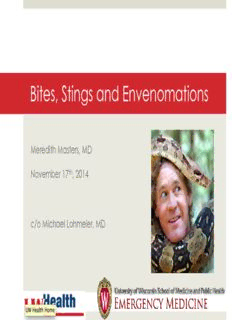
Bites, Stings and Envenomations PDF
Preview Bites, Stings and Envenomations
Bites, Stings and Envenomations Meredith Masters, MD November 17th, 2014 c/o Michael Lohmeier, MD Bites, Stings and Envenomations Objectives Review “common” envenomations Brief review of Biology Principles of prevention, diagnosis and management Envenomations Arthropods Insects (Hymenoptera) Spiders (Arachnid) Scorpions (Arachnid) Reptiles Pit Vipers (Crotalidae) Coral Snakes (Elapidae) Venomous Marine Life Bites, Stings and Envenomations Phylum Arthropoda Invertebrate, articulate legged animals At least 1 billion species (95% of total) Most successful life forms on Earth 4 Subphyla Trilobites (extinct) Chilicerates (spiders, scorpions, ticks) Uniramia (centipedes, millipedes, insects) Crustacea (crabs, lobster, shrimp) Bites, Stings and Envenomations Venomous Bites and Stings 50% insect stings 30% snake bites 14% spider bite 6% other Hymenoptera Bites, Stings and Envenomations Class: Insecta Order: Hymenoptera Bees, wasps, ants Account for more envenomation deaths than anything else 10 million stings per year 40-150 deaths per year Death usually due to immunologically mediated mechanism Bites, Stings and Envenomations Hymenoptera Problems Allergic Reaction Anaphylaxis Toxic venom effects (rare) About 40-150 deaths per year Honeybees 50% Yellow jackets and wasps 50% Bites, Stings and Envenomations Hymenoptera 0.4% of the population is at risk for serious allergic reaction Most give history of progressively severe response Some deny any prior stings or only normal reactions 50% of patients who had an allergic reaction had NO previous warning symptoms! Bites, Stings and Envenomations Hymenoptera Local reaction (wheal/urticaria) Sharp, burning pain Pruritis (itching) Edema Extensive reactions may involve the entire extremity Stings to tongue or throat may cause loss of airway Still a life threat, even though not anaphylaxis!! Bites, Stings and Envenomations Hymenoptera Systemic reactions Mild – diffuse itching, urticaria, swelling distant from site, flushing Severe – laryngeal edema, severe bronchospasm profound hypotension Systemic reations Most deaths (75%) occur within 4 hours of the sting
Description: